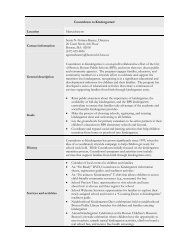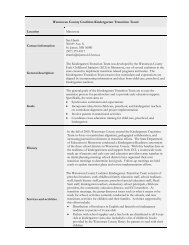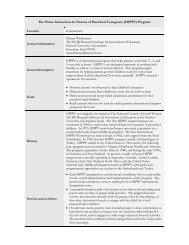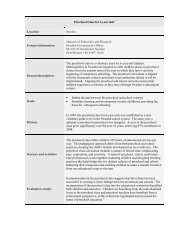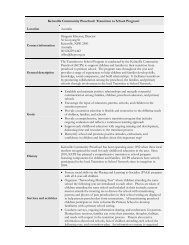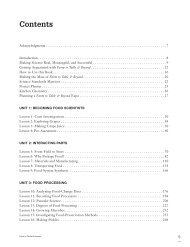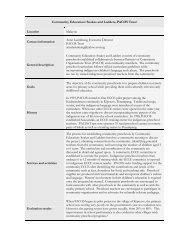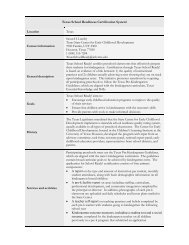Proceedings of the Fourth Annual Teachers College Educational ...
Proceedings of the Fourth Annual Teachers College Educational ...
Proceedings of the Fourth Annual Teachers College Educational ...
Create successful ePaper yourself
Turn your PDF publications into a flip-book with our unique Google optimized e-Paper software.
Guidelines for an Online Networking Space for Design Learning<br />
Pinar Ceyhan,<br />
Columbia University, 525 W. 120th St. New York,<br />
Email: pc2496@tc.columbia.edu<br />
Abstract: Tracing back to Ecole Des Beaux Arts design studio has always been central<br />
to design education. In design studio students learn from <strong>the</strong>ir peers, by <strong>the</strong> guidance <strong>of</strong><br />
a master teacher (Broadfoot & Bennett, 2003). Since design education is built upon<br />
learning by doing within <strong>the</strong> design community at school, an Online Social Networking<br />
Space designed specifically for designers, replicating and extending <strong>the</strong> community in<br />
studio, has potential to enrich this experience. Fur<strong>the</strong>rmore, by connecting students with<br />
<strong>the</strong>ir peers, teachers, o<strong>the</strong>r institutions and pr<strong>of</strong>essionals, within and outside <strong>of</strong> school<br />
regardless <strong>of</strong> <strong>the</strong>ir proximity to each o<strong>the</strong>r, it can also provide opportunities for an<br />
informal and lifelong learning. The goal <strong>of</strong> this research is to identify guidelines for a<br />
conceptual online networking space, enhancing design studio experience for explicit<br />
design learning to happen, while taking design pedagogy and <strong>the</strong> interaction <strong>of</strong>fered by<br />
current design networking sites into consideration.<br />
Habraken (2007) identifies “good judgement” as what makes <strong>the</strong> final form in design, and design studio<br />
as <strong>the</strong> ideal setting to learn <strong>the</strong> art <strong>of</strong> good judgment. On <strong>the</strong> o<strong>the</strong>r hand, he criticizes <strong>the</strong> studio setting as<br />
being limited to <strong>the</strong> teacher's preferences, resulting in predominantly implicit teaching and imitative<br />
learning (Habraken, 2007). As <strong>the</strong>y are developing <strong>the</strong>ir personal design vision at school, exposing<br />
students to different design perspectives can help avoiding imitative learning Habraken warns us about.<br />
Expanding Kamihira, Aoki & Nakano’s pedagogical model if students share <strong>the</strong>ir ideas and projects in a<br />
network <strong>of</strong> o<strong>the</strong>r students and designers, <strong>the</strong>y will have <strong>the</strong> chance to get feedback and learn from a<br />
broader design community (Figure 1). An online-networked space, with a broader user pr<strong>of</strong>ile from both<br />
academia and pr<strong>of</strong>essional design community can extend <strong>the</strong> social context <strong>of</strong>fered in <strong>the</strong> design studio,<br />
and introduce students to new ideas and points <strong>of</strong> view.<br />
Designing in remote collaboration has been explored as early as 1988 (Broadfoot & Bennett, 2003). The<br />
use <strong>of</strong> information and Communication Technologies enabled working on projects in Virtual Design<br />
Studios. Although successful collaborations were established, <strong>the</strong> medium posed challenges in<br />
establishing effective communication. Rapid developments in technology naturally rendered some <strong>of</strong> <strong>the</strong><br />
earlier communication and presentation issues irrelevant today. Subsequently we see more studies on<br />
reflective and collaborative design learning, where online social networking is utilized as a communication<br />
and file-sharing platform (Kamihira, Aoki & Nakano, 2011). The research evaluated some <strong>of</strong> <strong>the</strong> earlier<br />
and recent studies conducted in design schools on designing in remote collaboration, in order to come up<br />
with guidelines for a networking platform where <strong>the</strong> main focus would be supporting design learning.<br />
In order to identify which features <strong>of</strong> current networking sites can support design education, and what<br />
o<strong>the</strong>r features can be implemented to support design learning, four websites; DeviantArt, Etsy,<br />
Design:Related and Design21: Social Design Network were examined. All four <strong>of</strong> <strong>the</strong> sites enable<br />
networking, showcasing art and design work, and job search. In addition to <strong>the</strong>se, DeviantArt and Etsy<br />
also allow <strong>the</strong>ir members to sell <strong>the</strong>ir work online. Based on Maher, Paulini and Murty’s 2011 Analysis <strong>of</strong><br />
Successful Collective Intelligence Table, <strong>the</strong>se websites are assessed in representation <strong>of</strong> a Design<br />
problem and solution, communication and motivation (Table 1).<br />
The initial guidelines for an online social networking space for design learning are listed below:<br />
1- Networking platform for design education should support reflective writing<br />
2- Networking platform for design education should support archiving different kinds <strong>of</strong> file formats.<br />
3- Networking platform for design education should support creating linkage among blog posts and work<br />
created, and allow sorting to display various connections made by <strong>the</strong> student.<br />
4- Networking platform for design education should allow mobility.<br />
5- Networking platform for design education should enlist <strong>the</strong> collaboration <strong>of</strong> independent API<br />
developers and companies creating digital tools for design.<br />
4



